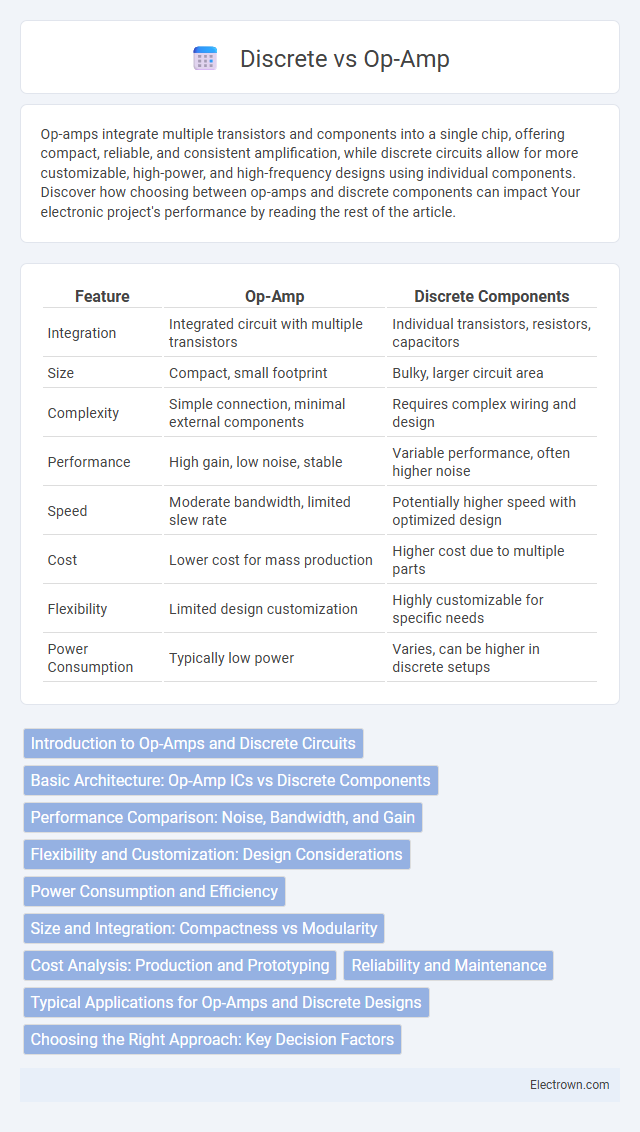Op-amps integrate multiple transistors and components into a single chip, offering compact, reliable, and consistent amplification, while discrete circuits allow for more customizable, high-power, and high-frequency designs using individual components. Discover how choosing between op-amps and discrete components can impact Your electronic project's performance by reading the rest of the article.
Table of Comparison
| Feature | Op-Amp | Discrete Components |
|---|---|---|
| Integration | Integrated circuit with multiple transistors | Individual transistors, resistors, capacitors |
| Size | Compact, small footprint | Bulky, larger circuit area |
| Complexity | Simple connection, minimal external components | Requires complex wiring and design |
| Performance | High gain, low noise, stable | Variable performance, often higher noise |
| Speed | Moderate bandwidth, limited slew rate | Potentially higher speed with optimized design |
| Cost | Lower cost for mass production | Higher cost due to multiple parts |
| Flexibility | Limited design customization | Highly customizable for specific needs |
| Power Consumption | Typically low power | Varies, can be higher in discrete setups |
Introduction to Op-Amps and Discrete Circuits
Operational amplifiers (op-amps) are integrated circuits designed for high-gain voltage amplification and versatile signal processing, offering compact design and consistent performance. Discrete circuits, composed of individual components like transistors and resistors, provide greater customization and are preferred in applications demanding specific characteristics or higher power handling. Understanding your project's requirements helps determine whether the precision and simplicity of op-amps or the tailored control of discrete circuits best suits your design needs.
Basic Architecture: Op-Amp ICs vs Discrete Components
Op-amp ICs integrate multiple transistors, resistors, and capacitors into a compact silicon chip, providing high gain and stable performance with minimal external components. Discrete component designs use individual transistors and passive elements wired on a PCB, offering flexible circuit customization but requiring more space and manual tuning. The integrated architecture of op-amps ensures predictable behavior and reduced noise, while discrete designs allow tailored solutions for specific high-frequency or power applications.
Performance Comparison: Noise, Bandwidth, and Gain
Op-amps generally offer lower noise levels, higher bandwidth, and more consistent gain compared to discrete transistor circuits, making them ideal for precision applications. Discrete designs may provide higher gain flexibility and better control over specific performance parameters but often introduce more noise and bandwidth limitations due to component variability. Your choice between an op-amp and discrete setup should consider the trade-offs in noise performance, bandwidth requirements, and desired gain stability for optimal circuit function.
Flexibility and Customization: Design Considerations
Discrete components offer greater flexibility and customization for your circuit designs, allowing precise control over each stage and component value to tailor performance. Op-amps provide simplified integration with fixed internal configurations, which streamlines design but limits the ability to adjust parameters like gain bandwidth product and input offset voltage. When considering design, discrete solutions excel in applications needing unique performance fine-tuning, while op-amps are ideal for standardized, space-saving implementations requiring less customization.
Power Consumption and Efficiency
Op-amps typically offer lower power consumption and higher efficiency due to their integrated design, which minimizes energy loss and heat generation compared to discrete component circuits. Discrete circuits, built from individual transistors and resistors, often consume more power and exhibit less efficient operation due to higher parasitic losses and increased complexity. Choosing an op-amp can optimize your system for energy-efficient performance, especially in battery-powered or low-energy applications.
Size and Integration: Compactness vs Modularity
Operational amplifiers (op-amps) offer a highly compact, integrated solution ideal for space-constrained applications, incorporating multiple transistors and components within a single package. Discrete component circuits provide modularity and flexibility by allowing individual selection and customization of each transistor and resistor, but they occupy significantly more board space. The choice between op-amps and discrete designs hinges on the trade-off between compact size and the ability to tailor circuit parameters at the component level.
Cost Analysis: Production and Prototyping
Op-amps offer a cost-effective solution for production and prototyping due to their integrated design, reducing component count and assembly time. Discrete designs typically incur higher material and labor expenses, as each transistor and resistor must be individually sourced and assembled. Your choice impacts overall budget efficiency, with op-amps favoring low-cost scalability in mass production.
Reliability and Maintenance
Op-amps offer higher reliability in electronic circuits due to their integrated design, which minimizes component variability and reduces the risk of failure. Discrete component assemblies often require more frequent maintenance because individual parts like resistors, capacitors, and transistors can degrade or drift over time. Your choice between op-amps and discrete designs impacts long-term stability, with op-amps generally providing lower maintenance needs and improved operational consistency.
Typical Applications for Op-Amps and Discrete Designs
Op-amps are commonly used in signal amplification, active filtering, and analog computation due to their high gain, linearity, and ease of integration in compact circuits. Discrete designs excel in high-frequency applications, power amplification, and situations requiring custom transistor configurations for specific performance traits such as low noise or high voltage tolerance. Typical applications for op-amps include audio preamplifiers, instrumentation amplifiers, and voltage followers, while discrete components are preferred in RF amplifiers, power output stages, and specialized sensor interfaces.
Choosing the Right Approach: Key Decision Factors
Choosing between op-amps and discrete components depends on factors like complexity, design flexibility, and performance requirements. Op-amps offer integrated solutions with consistent gain, low noise, and ease of implementation, ideal for compact and reliable circuits. Your choice should weigh discrete designs for high customization and power handling against op-amps for simplicity and efficiency.
op-amp vs discrete Infographic

 electrown.com
electrown.com